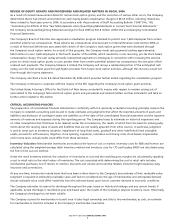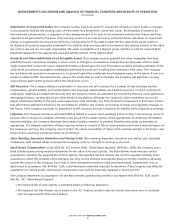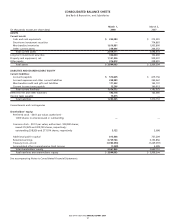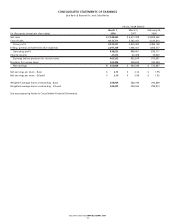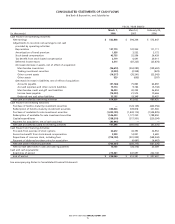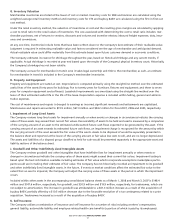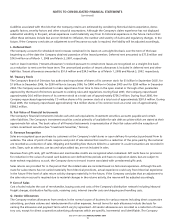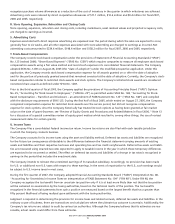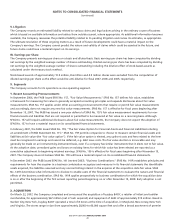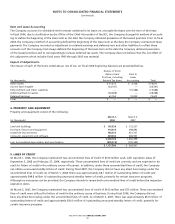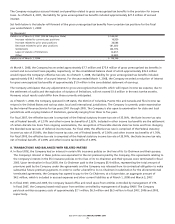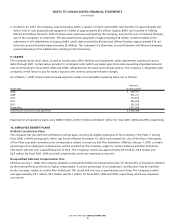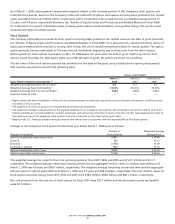Bed, Bath and Beyond 2007 Annual Report Download - page 21
Download and view the complete annual report
Please find page 21 of the 2007 Bed, Bath and Beyond annual report below. You can navigate through the pages in the report by either clicking on the pages listed below, or by using the keyword search tool below to find specific information within the annual report.BED BATH& BEYOND ANNUAL REPORT 2007
19
recognizes purchase volume allowances as a reduction of the cost of inventory in the quarter in which milestones are achieved.
Advertising costs were reduced by direct cooperative allowances of $11.1 million, $10.6 million and $9.4 million for fiscal 2007,
2006 and 2005, respectively.
R. Store Opening, Expansion, Relocation and Closing Costs
Store opening, expansion, relocation and closing costs, including markdowns, asset residual values and projected occupancy costs,
are charged to earnings as incurred.
S. Advertising Costs
Expenses associated with direct response advertising are expensed over the period during which the sales are expected to occur,
generally four to six weeks, and all other expenses associated with store advertising are charged to earnings as incurred. Net
advertising costs amounted to $239.6 million, $198.4 million and $158.2 million for fiscal 2007, 2006 and 2005, respectively.
T. Stock-Based Compensation
The Company records stock-based compensation under the provisions of Statement of Financial Accounting Standards (“SFAS”)
No. 123 (revised 2004), “Share-Based Payment” (“SFAS No. 123R”) which requires companies to measure all employee stock-based
compensation awards using a fair value method and record such expense in its consolidated financial statements. The Company
adopted SFAS No. 123R on August 28, 2005 (the “date of adoption”) under the modified prospective application. Under this
application, the Company records stock-based compensation expense for all awards granted on or after the date of adoption
and for the portion of previously granted awards that remained unvested at the date of adoption. Currently, the Company’s stock-
based compensation relates to restricted stock awards and stock options. The Company’s restricted stock awards are considered
nonvested share awards as defined under SFAS No. 123R.
Prior to the third quarter of fiscal 2005, the Company applied the provisions of Accounting Principles Board (“APB”) Opinion
No. 25, “Accounting for Stock Issued to Employees,” (“APB No. 25”) as permitted under SFAS No. 148, “Accounting for Stock-
Based Compensation – Transition and Disclosure – an amendment of FASB Statement No. 123” (“SFAS No. 148”) and complied
with the disclosure requirements of SFAS 123. During the first half of fiscal 2005, which ended on August 27, 2005, the Company
recognized compensation expense for restricted stock awards over the service period, but did not recognize compensation
expense for stock options, since the Company historically has treated its stock options as having been granted at fair market
value on the date of grant (however, see “Review of Equity Grants and Procedures and Related Matters in Fiscal 2006, ” Note 13
for a discussion of a special committee review of equity grant matters which resulted in, among other things, the use of revised
measurement dates for certain grants).
U. Income Taxes
The Company files a consolidated Federal income tax return. Income tax returns are also filed with each taxable jurisdiction
in which the Company conducts business.
The Company accounts for its income taxes using the asset and liability method. Deferred tax assets and liabilities are recognized
for the future tax consequences attributable to the differences between the financial statement carrying amounts of existing
assets and liabilities and their respective tax bases and operating loss and tax credit carryforwards. Deferred tax assets and liabili-
ties are measured using enacted tax rates expected to apply to taxable income in the year in which those temporary differences
are expected to be recovered or settled. The effect on deferred tax assets and liabilities of a change in tax rates is recognized in
earnings in the period that includes the enactment date.
The Company intends to reinvest the unremitted earnings of its Canadian subsidiary. Accordingly, no provision has been made
for U.S. or additional non-U.S. taxes with respect to these earnings. In the event of repatriation to the U.S., such earnings would
be subject to U.S. income taxes in most cases.
During the first quarter of 2007, the Company adopted Financial Accounting Standards Board (“FASB”) Interpretation No. 48,
“Accounting for Uncertainty in Income Taxes-an Interpretation of FASB Statement No. 109” (“FIN 48”). Under FIN 48, the
Company recognizes the tax benefit from an uncertain tax position only if it is at least more likely than not that the tax position
will be sustained on examination by the taxing authorities, based on the technical merits of the position. The tax benefits
recognized in the financial statements from such a position are measured based on the largest benefit that has a greater than
fifty percent likelihood of being realized upon settlement with the taxing authorities.
Judgment is required in determining the provision for income taxes and related accruals, deferred tax assets and liabilities. In the
ordinary course of business, there are transactions and calculations where the ultimate tax outcome is uncertain. Additionally, the
Company’s tax returns are subject to audit by various tax authorities. Although the Company believes that its estimates are rea-
sonable, actual results could differ from these estimates.


